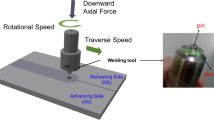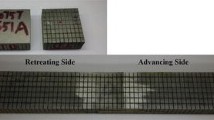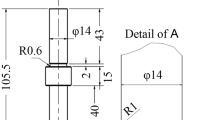Abstract
The residual stress generated during the welding process affects the mechanical properties of the material. In this study, a measurement method of residual stress fields in the friction stir welded zone is developed based on the plastic strain increment and Mises yield criterion. First, the relationship among the residual stress, the measured local yield strength, and the plastic strain increment is derived according to the Mises yield criterion. Then, through uniaxial tensile tests, the stress–strain curve of any point in the friction stir welded zone is obtained using the digital image correlation method. Finally, the distribution of residual stress around the friction stir welded zone is characterized by the derived relationship on the basis of accurately obtaining the local yield strength. The feasibility of the method developed in this paper for measuring residual stress is verified by comparison with the results of the mechanical method combined with the charge coupled device Moiré method. Additionally, other material parameters such as modulus and yield strength can also be measured at the same time. The proposed method is applied to a mechanical properties evaluation of the friction stir welded joint of an aluminum alloy 6061T6 thin plate. The results show that the residual stress around the weld is tensile, showing a bimodal distribution, and the peak value of the residual stress is located in the thermomechanical affected zone. The strength has a double-valley distribution, and the local yield strength of the thermomechanical affected zone is the lowest. The mechanical properties of the thermomechanical affected zone are relatively poor, and it is the location that is prone to fracture.












Similar content being viewed by others
References
W.F. Xu, Y.X. Luo, and M.W. Fu, Microstructure evolution in the conventional single side and bobbin tool friction stir welding of thick rolled 7085–T7452 aluminum alloy, Mater. Charact., 2018, 138, p 48–55. https://doi.org/10.1016/j.matchar.2018.01.051
D. Li, X. Yang, L. Cui, F. He, and H. Shen, Effect of Welding Parameters on Microstructure and Mechanical Properties of AA6061-T6 Butt Welded Joints by Stationary shoulder Friction Stir Welding, Mater. Des., 2014, 64, p 251–260. https://doi.org/10.1016/j.matdes.2014.07.046
M. Peel, A. Steuwer, M. Preuss, and P.J. Withers, Microstructure, mechanical properties and residual stresses as a function of welding speed in aluminium AA5083 friction stir welds, Acta Mater., 2003, 51(16), p 4791–4801. https://doi.org/10.1016/S1359-6454(03)00319-7
V. Moosabeiki, G. Azimi, and M. Ghayoor, Influences of Tool Pin Profile and Tool Shoulder Curvature on the Formation of Friction Stir Welding Zone in AA6061 Aluminium Alloy, Adv. Mater. Res., 2012 https://doi.org/10.4028/www.scientific.net/AMR.445.789
Moshwan R, Yusof F, Hassan MA, and Rahmat SM. (2015). Effect of Tool Rotational Speed on Force Generation, Microstructure and Mechanical Properties of Friction Stir Welded Al-Mg-Cr-Mn (AA 5052O) Alloy. Mater Des (1980–2015). 66: 118–128
X. Wu, J. Shuai, K. Xu, and Z. Lv, Local Constitutive Behavior of Undermatched Welded Joints in Pipeline Steel Using Digital Image Correlation Technology, J. Press. Vessel Technol., 2020, 142, p 5. https://doi.org/10.1115/1.4047271
B. Chen and B. Pan, Measuring True Stress–Strain Curves of Cylindrical bar Samples with Mirror-Assisted Multi-View Digital Image Correlation, Strain, 2022 https://doi.org/10.1111/str.12403
Ł Skarżyński and J. Tejchman, Experimental investigations of fracture process using DIC in plain and reinforced concrete beams under bending, Strain, 2013, 49(6), p 521–543. https://doi.org/10.1111/str.12064
G. Srinivasa Rao, V.V. Subba Rao, and S.R.K. Rao, Microstructure and Mechanical Properties of Welded Joints of Aluminum Alloy AA7020-T6 Obtained by Friction Stir Welding, Metal Sci. Heat Treat., 2017 https://doi.org/10.1007/s11041-017-0117-x
H.J.K. Lemmen, R.C. Alderliesten, R.R.G.M. Pieters, R. Benedictus, and J.A. Pineault, Yield Strength and Residual Stress Measurements on Friction-Stir-Welded Aluminum Alloys, J. Aircr., 2010, 47(5), p 1570–1583. https://doi.org/10.2514/1.C000212
R. Bai, Y. Wei, Z. Lei, H. Jiang, W. Tao, C. Yan, and X. Li, Local Zone-Wise Elastic-plastic Constitutive Parameters of Laser-Welded Aluminium Alloy 6061 using Digital Image Correlation, Opt. Lasers Eng., 2018, 101, p 28–34. https://doi.org/10.1016/j.optlaseng.2017.09.023
N.S. Rossini, M. Dassisti, K.Y. Benyounis, and A.G. Olabi, Methods of Measuring Residual Stresses in Components, Mater. Des., 2012, 35, p 572–588. https://doi.org/10.1016/j.matdes.2011.08.022
X. Huang, Z. Liu, and H. Xie, Recent Progress in Residual Stress Measurement Techniques, Acta Mech. Solida Sin., 2013, 26(6), p 570–583. https://doi.org/10.1016/S0894-9166(14)60002-1
P. Ji, Z. Yang, J. Zhang, L. Zheng, V. Ji, and V. Klosek, Residual Stress Distribution and Microstructure in the Friction Stir Weld of 7075 Aluminum Alloy, J. Mater. Sci., 2015, 50(22), p 7262–7270. https://doi.org/10.1007/s10853-015-9280-x
J. Lu, Handbook of Measurement of Residual stresses, Bethel, SEM, 1996, p 319–22
R. Von Mises, Mechanics of the Ductile form Changes of Crystals, Z. Fur Angew. Math. Und Mech., 1928, 8, p 161–185. https://doi.org/10.1002/zamm.19280080302
H.H.Y.N.W. Gao, Y. Huang, W.D. Nix, and J. Hutchinson, Mechanism-based Strain Gradient Plasticity—I. Theory, J. Mech. Phys. Solids, 1999, 47(6), p 1239–1263. https://doi.org/10.1016/S0022-5096(98)00103-3
M.W. Mahoney, C.G. Rhodes, J.G. Flintoff, W.H. Bingel, and R.A. Spurling, Properties of Friction-Stir-Welded 7075 T651 Aluminum, Metall. Mater. Trans. A., 1998, 29(7), p 1955–1964. https://doi.org/10.1007/s11661-998-0021-5
J. Blaber, B. Adair, and A. Antoniou, Ncorr: Open-Source 2D Digital Image Correlation Matlab Software, Experim. Mech., 2015 https://doi.org/10.1007/s11340-015-0009-1
R.K.R. Singh et al., The Microstructure and Mechanical Properties of Friction stir Welded Al-Zn-Mg Alloy in as Welded and Heat Treated Conditions, Mater. Des., 2011, 32(2), p 682–687. https://doi.org/10.1016/j.matdes.2010.08.001
N.-V. Nguyen, T.-H. Pham, and S.-E. Kim, Microstructure and Strain Rate Sensitivity Behavior of SM490 Structural Steel Weld Zone Investigated Using Indentation, Constr. Build. Mater., 2019, 206, p 410–418. https://doi.org/10.1016/j.conbuildmat.2019.02.013
Y.X. Huang, L. Wan, Z.L. Lv, S.X. Lv, L. Zhou, and J. Feng, Microstructure and Microhardness of Aluminium Alloy Friction stir Welds with Heat Treatment, Sci. Technol. Weld. Joining, 2016, 21(8), p 638–644. https://doi.org/10.1080/13621718.2016.1152748
I. Hejazi and S.E. Mirsalehi, Mechanical and Metallurgical Characterization of AA6061 Friction Stir Welded Joints using Microhardness Map, Trans. Nonf. Metals Soc. China, 2016, 26(9), p 2313–2319. https://doi.org/10.1016/S1003-6326(16)64351-0
I. Hejazi and S.E. Mirsalehi, Mechanical and Metallurgical Characterization of AA6061 Friction Stir Welded Joints using Microhardness Map, Trans. Nonf. Metals Soc. China, 2016, 26(9), p 2313–2319. https://doi.org/10.1016/S1003-6326(16)64351-0
X. Liu, P. Xie, R. Wimpory, W. Li, R. Lai, M. Li, D. Chen, Y. Liu, and H. Zhao, Residual Stress, Microstructure and Mechanical Properties in Thick 6005A–T6 Aluminium Alloy Friction Stir Welds, Metals, 2019, 9(7), p 803. https://doi.org/10.3390/met9070803
I. Alinaghian, S. Amini, and M. Honarpisheh, Residual Stress, Tensile Strength, and Macrostructure Investigations on Ultrasonic Assisted Friction Stir Welding of AA 6061–T6, J. Strain Anal. Eng. Des., 2018, 53(7), p 494–503. https://doi.org/10.1177/0309324718789768
Sheng Lu et al., Microstructures and mechanical properties of Mg alloy FSW joint characterized with asymmetric gradient in three dimension, Materials Science Forum. Trans Tech Publications Ltd, Stafa-Zurich, 2013, p 104–121
S.L. Li, Z.Q. Huang, F.L. Jiang, W.P. Chen, Z.M. Liu, and W.J. Qi, Effect of Solution Temperature on Microstructure and Property of a 6061 Aluminum Alloy, Transact. Mater. Heat Treat., 2013, 34(5), p 131–136. https://doi.org/10.13289/j.issn.10096264.2013.05.026
A. Simar, Y. Bréchet, B. De Meester, A. Denquin, C. Gallais, and T. Pardoen, Integrated Modeling of Friction Stir Welding of 6xxx Series Al Alloys: Process, Microstructure and Properties, Prog. Mater. Sci., 2012, 57(1), p 95–183. https://doi.org/10.1016/j.pmatsci.2011.05.003
H. Zhang, C. Wu, Z. Liu, and H. Xie, A Curved Surface Micro-Moiré Method and its Application in Evaluating Curved Surface Residual Stress, Measure. Sci. Technol., 2014, 25(9), p 095002. https://doi.org/10.1088/0957-0233/25/9/095002
Y. Guo, X. Zhang, X. Qian, and J. Li, Study on Residual Stress Distribution of 2024–T3 and 7075–T6 Aluminum Dissimilar Friction Stir Welded Joints, Eng. Fail. Anal., 2020, 118, p 104911. https://doi.org/10.1016/j.engfailanal.2020.104911
W. Woo et al., Neutron Diffraction Measurements of Residual Stresses in Friction Stir Welding: A Review, Sci. Technol. Weld. Join., 2011, 16(1), p 23–32. https://doi.org/10.1179/136217110X12731414739916
Michael B. Prime et al., Residual Stress Measurements in a Thick, Dissimilar Aluminum Alloy Friction Stir Weld, Acta Mater., 2006, 54(15), p 4013–4021. https://doi.org/10.1016/j.actamat.2006.04.034
W. Woo and H. Choo, Softening Behaviour of Friction Stir Welded Al 6061–T6 and Mg AZ31B Alloys, Sci. Technol. Weld. Join., 2011, 16(3), p 267–272. https://doi.org/10.1179/1362171811Y.0000000016
Acknowledgments
This work was financially supported by the National Natural Science Foundation of China [Grant No. 11972084], National Science and Technology Major Project (2017-VI-0003-0073) and Beijing National Science Foundation (1192014).
Author information
Authors and Affiliations
Corresponding author
Additional information
Publisher's Note
Springer Nature remains neutral with regard to jurisdictional claims in published maps and institutional affiliations.
Rights and permissions
About this article
Cite this article
Li, Y., Zhao, J., Zhou, J. et al. Evaluation of Residual Stress Fields in Friction Stir Welded Zone Based on the Plastic Strain Increment and Mises Yield Criterion. J. of Materi Eng and Perform 32, 5466–5474 (2023). https://doi.org/10.1007/s11665-022-07477-x
Received:
Revised:
Accepted:
Published:
Issue Date:
DOI: https://doi.org/10.1007/s11665-022-07477-x




